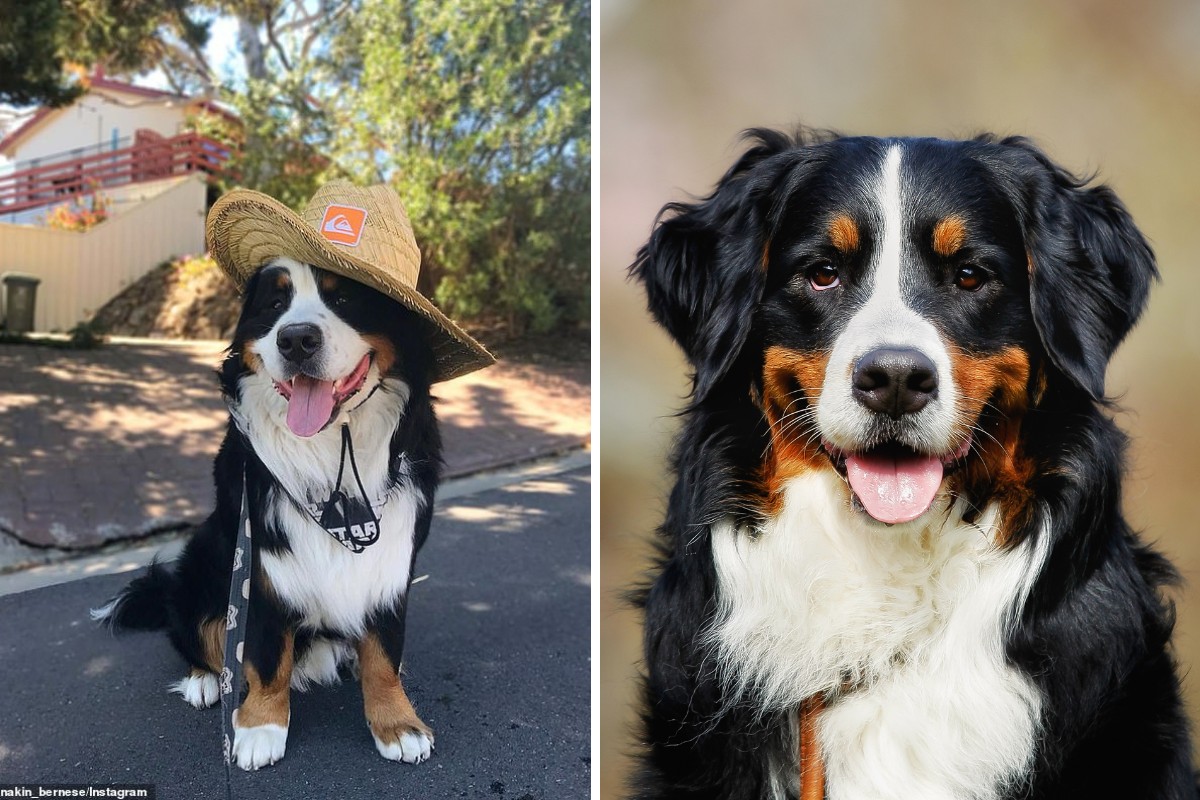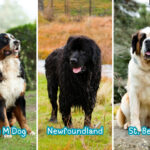 31 Oct
31 Oct9 Interesting Facts About Bernese Mountain Dogs
Bernese Mountain Dogs have a certain allure that’s hard to resist. With their striking tri-color coats, gentle eyes, and robust stature, it’s easy to see why they’ve charmed so many hearts worldwide. As a seasoned dog parent and writer, I’ve come across countless dog breeds, each with their own unique qualities.
But there’s something particularly captivating about the Bernese Mountain Dog. In this article, we’ll uncover nine fascinating facts about these Swiss beauties.
Whether you’re a proud owner or simply an admirer from afar, there’s always something new to learn about this endearing breed. So, are you ready to get to know the Bernese Mountain Dog a little better? Let’s get started!
The Bernese Mountain Dog, affectionately known as the “Berner,” traces its lineage back to the heart of Switzerland. Nestled amidst the towering Alps and picturesque valleys, these dogs have been a beloved part of Swiss culture for centuries.
Historical records suggest that the Bernese Mountain Dog descended from mastiff-type dogs brought by the Roman soldiers during their conquests. Over time, these dogs interbred with local breeds, ultimately giving rise to the Berner we know today.
Their sturdy build and diligent work ethic made them invaluable assets on Swiss farms. Not just companions, these dogs had jobs – and they took them seriously. They were primarily used for pulling carts, a task their strength made them particularly suited for. Additionally, with their watchful eyes and protective nature, they were trusted to herd livestock, ensuring that cows and sheep were safe from both predators and straying too far from home.
While their roles have evolved over the years, with many now enjoying the leisurely life of a family pet, their historical significance as diligent farm dogs remains a proud part of their legacy.

Fact #2. Distinct Tri-Color Appearance
One of the most distinctive features of the Bernese Mountain Dog is its mesmerizing tri-color coat. A harmonious blend of black, white, and rust creates a visual spectacle that’s hard to miss.
The majority of their body boasts a rich black, providing a canvas for the other two colors to shine. The rust typically adorns their eyebrows, cheeks, and legs, adding warmth to their appearance. Then there’s the white – which elegantly contrasts the deeper shades. You’ll often find it on their muzzle, chest, toes, and the tip of their tail. Some Berners even have a unique white blaze that runs from their forehead to the muzzle, resembling a beautiful inverted comma.
But these colors aren’t merely for show. Historically, the markings had functional significance. The white on their chest made them more visible in the dark, especially during early morning or late evening farm tasks. Their patterns, while varying slightly from one Berner to another, follow a general standard that has been celebrated and preserved by breed enthusiasts and breeders for generations.
Today, while the functional need for their markings might have lessened, it remain an integral part of what makes a Bernese Mountain Dog so captivating, cementing their place as one of the most recognizable breeds in the canine world.
Fact #3. Lifespan and Health
When it comes to the Bernese Mountain Dog, their heartwarming presence is only eclipsed by the wish that they’d accompany us for even longer. Typically, a Berner’s lifespan ranges between 7 to 10 years. While this might seem shorter than some other breeds, it’s essential to note that larger dog breeds often have shorter lifespans in general.
Like all breeds, Bernese Mountain Dogs have their set of health concerns to be watchful for. Some of the common issues include hip and elbow dysplasia, which are joint conditions that can affect their mobility. They’re also prone to certain genetic conditions like progressive retinal atrophy, which affects their eyesight, and von Willebrand’s disease, a blood-clotting disorder.
Given these health considerations, regular vet check-ups are paramount. These visits allow for early detection of potential problems, ensuring that our furry friends remain in the best health possible. As prevention is always better than cure, many Berner parents opt for genetic testing. This helps in identifying potential hereditary issues early on, allowing for better management and care.

Fact #4. Gentle Giants with a Kind Nature
There’s a gentle irony in the world of dogs: often, the bigger they are, the softer their hearts. The Bernese Mountain Dog stands as a testament to this. For all their imposing size and robust frame, they’re nothing short of gentle giants, brimming with love and affection.
Known for their friendly disposition, Berners wear their heart on their furry sleeves. They have a natural tendency to bond with their human family, often displaying a level of loyalty and devotion that’s genuinely heartwarming. Their kind eyes and wagging tail are often the first to greet you, whether it’s been five minutes or five hours since they last saw you.
This friendly nature extends beyond their immediate family, making them excellent companions for households with children. Their patient demeanor and protective instincts create a bond with kids that’s both endearing and reassuring for parents. While it’s always essential to supervise interactions between pets and young children, Berners are generally known to be gentle playmates, often indulging in the innocent antics of their little human friends.
However, as is the case with all dogs, early socialization is key. Exposing them to various environments, people, and other pets during their formative months ensures that they grow up to be well-rounded, confident adults.
Fact #5. They’re Talkative in Their Own Way
If dogs had a language, the Bernese Mountain Dog would certainly be among the eloquent speakers. While they might not “talk” in the traditional sense, Berners have a rich vocabulary of vocal expressions that convey a spectrum of emotions and needs.
Their barks, for instance, aren’t just generic sounds. There’s a difference between the deep, warning bark they use to alert you of a stranger and the more playful, spirited bark that says, “Hey, it’s playtime!” Then there are the whines, which can range from a soft plea for attention to a more insistent reminder that maybe it’s time for their dinner or a walk.
Beyond these overt vocalizations, the Bernese Mountain Dog often employs a series of huffs, grunts, and sighs. These nuanced sounds provide keen listeners with insights into their mood, be it contentment, curiosity, or just a lazy Sunday afternoon stretch.
Communication with other animals is equally expressive. Playful growls during a game with another dog, gentle whimpers when approaching a cat, or even an excited yip when spotting a familiar furry friend from afar – each sound tells a story.
For a Berner parent, understanding these vocal cues becomes second nature over time. It strengthens the bond between the dog and the owner, allowing for a deeper connection and mutual understanding. It’s like learning a new language, where the reward is a richer, more fulfilling relationship with your four-legged companion.

Fact #6. Intelligence and Trainability
The world of dogs is brimming with intelligent breeds, and the Bernese Mountain Dog proudly stands among them. Stemming from their working dog heritage, they possess a keen intellect, making them both astute observers and swift learners.
Historically, their tasks on Swiss farms demanded not just physical strength but also mental agility. Whether herding livestock or pulling carts, Berners had to understand and respond to a range of commands. This innate ability to comprehend and act translates seamlessly into their trainability. They’re eager to please, which, combined with their intelligence, makes the training process smoother than one might expect for a dog of their size.
When it comes to training tips, positive reinforcement is the golden rule. Berners respond well to rewards, be it treats, praise, or playtime. Consistency is key; regular, short training sessions ensure they remain engaged without getting overwhelmed.
Using clear commands and being patient will further aid in making training both effective and enjoyable. However, intelligence isn’t just about following commands. For Berners, early socialization plays a crucial role in shaping their temperament and behavior.
Introducing them to different environments, people, and animals during their puppy days helps in fostering a balanced and confident adult dog. It not only aids in training but also ensures that their intelligence is complemented by a well-adjusted personality.
Fact #7. Seasonal Shedding
Ah, the tale of the Bernese Mountain Dog’s magnificent coat! Luxurious and dense, it’s a sight to behold but also comes with its unique set of care requirements. Understanding their shedding patterns is pivotal for any Berner owner or enthusiast.
At the heart of Berner’s coat is a double-layered design. The outer coat is long, silky, and straight or slightly wavy, serving as a protective barrier against the elements. Beneath this lies the softer, woolly undercoat, which provides insulation, keeping the dog warm in colder climates and cooler in warmer months.
Given their mountainous origins, this double coat was vital for the Bernese, offering protection from the variable weather conditions of the Swiss Alps. However, this adaptive feature means that the Berner sheds, and quite profusely during certain times of the year.
Primarily, Berners go through two major shedding seasons: in the spring as they shed their thicker winter undercoat, and in the fall in preparation for the colder months. During these times, be prepared for a flurry of fur! Regular brushing, preferably daily, becomes indispensable. Not only does it help in managing the shedding, but it also keeps their coat healthy, reduces matting, and promotes better skin health.
Outside of these shedding seasons, a weekly brush should suffice. Additionally, investing in a good quality de-shedding tool and seeking occasional professional grooming can make the process more manageable and ensure your Berner looks and feels their best.

Fact #8. Celebrity Status in the Canine World
The Bernese Mountain Dog, with its striking appearance and endearing personality, has naturally captured the attention of not just dog lovers, but also the entertainment industry. From silver screens to the bustling world of social media, Berners have carved a niche for themselves, winning hearts and gaining celebrity status in the process.
Movies and TV shows often showcase Berners in roles that highlight their gentle nature and intelligence. Their eye-catching coat and majestic stance make them a favorite for scenes set in snowy landscapes or cozy family homes, creating an ambiance of warmth and comfort. Advertisers, too, are not immune to their charms. It’s not uncommon to spot a Berner in commercials, symbolizing trustworthiness, loyalty, or the simple joy of family life.
But perhaps the most contemporary claim to fame for the Bernese Mountain Dog lies in the realm of social media. With the rise of pet influencers on platforms like Instagram, TikTok, and YouTube, several Berners have amassed significant followings, becoming canine celebrities in their own right.
Their daily adventures, from playful antics to lazy lounging sessions, resonate with thousands, if not millions, turning them into internet sensations. These furry influencers often partner with pet brands, promote positive pet care practices, and simply spread joy with every post.
While it’s tempting to get lost in the stardom, at the core of every Berner’s celebrity status is their genuine nature, which remains unchanged whether they’re on a movie set, in a commercial, or playing in their backyard. It’s this authenticity, combined with their undeniable charisma, that ensures the Bernese Mountain Dog’s lasting impact in the limelight.
Fact #9. They Love Cold Weather
Hailing from the snowy terrains of the Swiss Alps, the Bernese Mountain Dog is in its element when the mercury drops. Their double coat, a remnant of their mountainous origins, serves as a natural insulator, making them well-suited for cooler climates.
The Berner’s preference for the cold is evident in their behavior. As winter approaches and the first snowflakes begin to fall, these dogs often become more energetic and playful. Snowy landscapes become their playgrounds, with many Berners delighting in romping around, making snow trails, or simply lounging in the chill, taking in the serene surroundings.
However, this affinity for colder weather does pose challenges when it comes to warmer temperatures. If you live in a region with hot summers or are considering bringing a Berner into a tropical climate, special care is required to ensure their well-being.
Firstly, it’s essential to provide them with a cool and shaded environment. When outdoors, try to limit their activity during the hottest parts of the day, opting for early morning or evening walks instead. Fresh water should always be accessible, ensuring they remain hydrated.
Additionally, while it might be tempting to trim their coat significantly to help them stay cool, resist the urge. Their double coat not only keeps them warm in the cold but also protects them from the sun and heat. Instead, focus on regular grooming to remove excess undercoat and promote air circulation.
Furthermore, be vigilant about signs of heat exhaustion or heatstroke, such as excessive panting, drooling, or lethargy. Immediate cooling and veterinary attention are crucial in such cases.
In summary, while the Bernese Mountain Dog has an innate love for cold weather, with mindful care, they can adapt and thrive in warmer climates, ensuring they remain happy and healthy no matter the season.




